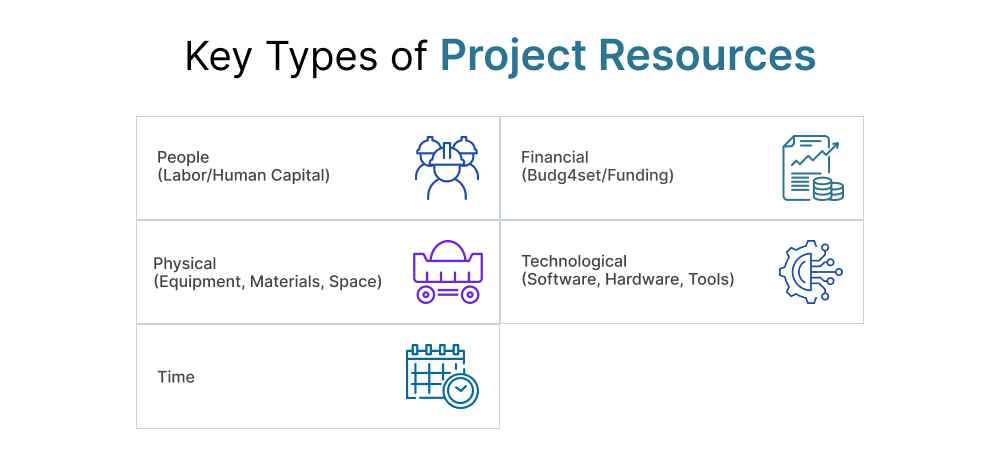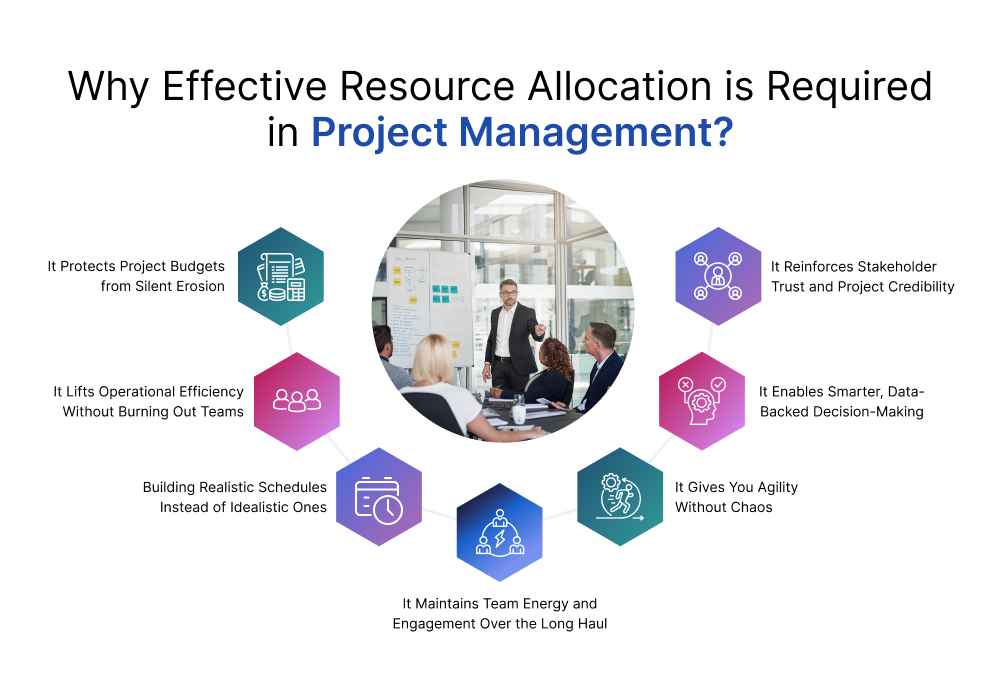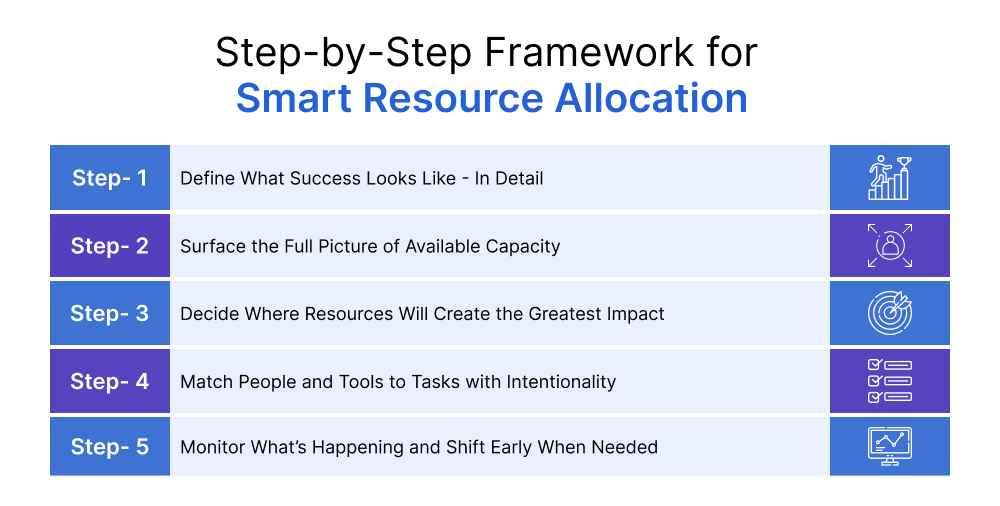
In project management, resources are the lifeblood of execution. Done well, allocation keeps delivery smooth, critical skills aren’t double?booked, milestones flow, and cost buffers hold. Done poorly, bottlenecks stack up, key people burn out, and you start paying in schedule slip and budget overrun. In other words, resource allocation is less a spreadsheet exercise and more the daily operating system of delivery.
A recent industry study even ranks resource management among the three hardest PM processes to embed, alongside benefits management and project prioritization, underscoring how pivotal (and persistently difficult) it is to get right.
Resource allocation is the strategic distribution of your project’s most valuable inputs, people, time, money, tools, and materials. But matching the right resources to the right work rarely stays simple: teams juggle multiple projects, budgets tighten midstream, and priorities shift without warning. That’s why effective allocation is not just planning hygiene, it’s a leadership capability.
| Consider NASA’s Mars Science Laboratory (Curiosity), which had a narrow launch window in late 2011. Missing it would have meant a 26-month delay and hundreds of millions in extra costs. When testing revealed a parachute deployment anomaly, leaders concentrated resources on resolving the issue, fast, while deferring less critical tasks. That targeted allocation protected both the schedule and the mission’s budget, illustrating how decisive leadership in resource allocation can determine success or failure. |
Whether you’re coordinating multiple workstreams, clearing delivery bottlenecks, or adapting to last-minute scope changes, the way you deploy resources directly shapes project outcomes, team morale, and cost efficiency. Organizations that invest in effective resource management cut wasted project spend nearly in half compared to those that don’t.
Foundations of Resource Allocation in Projects
What Is Resource Allocation?
Resource allocation in project management is the strategic process of assigning the right resources to the right tasks at the right time. It sounds straightforward. However, in reality, it’s a complex balancing act that involves shifting priorities, limited availability, and genuine human constraints.
In theory, it might seem like moving a camera from one shoot to another. In practice, you’re managing people, each with their skills, schedules, and circumstances. A developer could be splitting time between two major projects. A designer might be unexpectedly out sick. Your best analyst may now be working from a different time zone. Add in a fixed budget, a delayed shipment of equipment, or a sudden scope change, and it becomes clear that allocation isn’t just about assigning tasks; it’s about orchestrating moving parts under changing conditions.
That’s even more true in today’s work environment. With remote and hybrid teams, simply finding overlapping hours can be a challenge. Key specialists are in high demand, often booked across multiple projects at once. Software tools and cloud services are another pressure point; Gartner estimates companies overspend on them by as much as 30% due to poor license tracking. And according to PMI’s Pulse of the Profession, nearly two-thirds of projects face delays because resources aren’t aligned to the right work at the right time. On top of that, shifting market conditions can force budget changes mid-project, leaving managers to reshuffle priorities on the fly.
Orchestration starts at planning, but it never truly ends. Done well, it keeps projects on track, budgets intact, and teams resilient. Done poorly, it can stall progress, frustrate people, and drain confidence long before delivery.
A well-planned resource allocation strategy helps project managers:
- Optimize productivity by using available resources effectively
- Prevent team burnout by avoiding overutilization
- Adjust in real time to shifting workloads or priorities
- Reduce waste and keep budgets on track
- Deliver projects on time and with greater stakeholder satisfaction
Key Types of Project Resources
Successful resource allocation starts with understanding what you’re working with. Project resources typically fall into five major categories:
1. People (Labor/Human Capital)
This is often your most critical and complex resource. It includes employees, contractors, freelancers, and consultants, essentially anyone involved in executing the project. Effective allocation involves aligning people’s skills, capacities, interests, and availability with the project’s needs. It also requires factoring in leave, burnout risk, location/time zones, and role dependencies.
2. Financial (Budg4set/Funding)
Budget is the fuel that powers a project. Allocation involves ensuring that funds are distributed efficiently across phases, departments, and deliverables. Overspending on one task can starve another, so budget allocation must be tied closely to scope, timeline, and ROI expectations.
3. Physical (Equipment, Materials, Space)
This includes physical tools (e.g., machinery, vehicles), materials (e.g., steel, copper, office supplies), and operational space (e.g., offices, meeting rooms, construction sites). Physical resources often have usage timelines or constraints and must be carefully scheduled to avoid overlaps or shortages.
4. Technological (Software, Hardware, Tools)
From project management platforms to design tools and servers, technology resources are crucial enablers of productivity. Their allocation includes access management, license availability, and compatibility with team needs.
5. Time
Perhaps the most underestimated resource, time affects all others. Allocating time isn’t just about setting deadlines; it’s about ensuring resources are realistically scheduled, not overbooked, and able to work within interdependencies and constraints. A perfectly skilled team can still fail if their time is spread too thin or poorly managed.
Core Resource Allocation Methods and Strategies For Project Managers
Resource allocation isn’t just a scheduling task; it’s a strategic function that determines whether projects succeed on time, within budget, and without burning out the team. To navigate the growing complexity of modern projects, project leaders must go beyond instinct and adopt structured, proven methods.
Below is a deep dive into the eight most effective resource allocation methods, organized by their strategic goal, ranging from prioritizing task execution to managing resource constraints, optimizing timelines, and tracking performance.
A. Prioritising the Work That Matters Most
Critical Path Method (CPM)
Clarifying what can’t slip, no matter what.
CPM helps project managers focus on the sequence of tasks that directly determines the project’s completion date. It’s particularly effective when your project has a clear scope and the timing of activities is relatively predictable, such as in infrastructure projects or waterfall-style implementations.
By identifying the “critical path”, the longest chain of dependent tasks, you can see which delays would derail the whole timeline. That clarity helps allocate the team’s focus where it counts most. However, CPM works best when resources are assumed to be available on demand, which isn’t always realistic in cross-functional or lean teams. If you’re navigating a well-structured plan and need timeline visibility above all, CPM brings that backbone.
Real World Case Study
In a study at the University of Nigeria, Nsukka, researchers applied CPM to a large-scale lecture hall construction project. The initial plan estimated 425 days to completion. Still, CPM analysis revealed a set of 35 critical activities whose optimization reduced the project duration to 285 days — a savings of 133 days without sacrificing quality (Ezra et al., 2024). By mapping out the true critical path, project leaders were able to reallocate skilled labor, equipment, and budget away from non-critical tasks and concentrate them where delays would have the highest impact. This targeted resource deployment ensured that high-dependency tasks received uninterrupted attention, demonstrating how CPM is not just a scheduling tool but also a powerful framework for making high-impact resource allocation decisions in real-world projects.
PERT (Program Evaluation and Review Technique)
Preparing for what might go wrong – before it does
Projects with numerous unknowns, such as product R&D or exploratory software initiatives, rarely follow a straightforward path. PERT steps in with a probabilistic approach, using three time estimates (optimistic, pessimistic, and most likely) for each activity. That flexibility is its biggest strength: it embraces ambiguity instead of pretending it doesn’t exist.
The result? You gain a weighted timeline of risk factors, enabling more thoughtful resource allocation. This method is best suited for environments where you’re juggling uncertainty and need a buffer strategy built into your estimates, not just on paper, but in how you allocate your team’s bandwidth across risky or variable efforts.
Case Point
In the same University of Nigeria, Nsukka, lecture hall construction project, the team applied PERT alongside CPM to manage uncertainty in activity durations. While CPM identified the fixed sequence of critical activities, PERT’s three-point estimates highlighted tasks with the greatest time variability. This insight allowed project leaders to strategically allocate contingency resources, such as standby labor teams, backup equipment, and budget reserves, to activities most at risk of delay. By proactively reserving these resources where they would have the highest impact, the team ensured that unpredictable tasks could be absorbed without affecting the project’s overall delivery date. This demonstrates how PERT not only models uncertainty but also guides resource managers in prioritizing scarce capacity and funds in a way that protects the entire project from schedule and cost overruns.
B. Dealing with Bottlenecks, Constraints, and Shared Resources
Critical Chain Method (CCM)
Planning around people – not just tasks
Where CPM focuses on task order, CCM looks at people. In real-world projects, your plan often fails not because tasks weren’t aligned, but because one critical team member was pulled into another urgent task.
CCM introduces buffers to shield the schedule from such disruptions. By mapping both task dependencies and actual resource availability, it creates a timeline that respects human constraints.
| CCPM has helped organisations complete projects 10–50% faster and/or cheaper compared to traditional CPM or PERT approaches |
You’ll find this method most helpful in organisations where specialists are shared across projects, and timelines need built-in resilience, not just optimism.
Resource Leveling
Redesigning the plan to enable the team actually to deliver it
If you’ve ever seen a Gantt chart where one person is booked across three deliverables at once, you know the chaos of unrealistic planning. Resource levelling addresses this by adjusting the schedule to match available capacity, spreading work over a longer period instead of overloading individuals.
The trade-off is timeline flexibility. While your end date may shift, you gain a more sustainable workflow and avoid the hidden cost of burnout. It’s a go-to method when protecting people is just as important as protecting timelines.
Case in Point
A residential housing project faced repeated delays because the same electrical team was scheduled across overlapping deliverables. By applying resource leveling, the project team adjusted the project timeline to reflect true workforce availability. This reduced over-allocation, minimized rework, and created a more predictable delivery rhythm. While the completion date extended slightly, the team avoided costly burnout and quality failures.
Resource Smoothing
Balancing the load – without moving the deadline
Sometimes the deadline is non-negotiable, but there’s still room to tweak how the work is distributed. That’s where smoothing comes in. Instead of stretching the schedule, it redistributes tasks within existing slack to avoid spikes in workload.
It works particularly well in structured environments where the project has enough float between tasks to allow reallocation, but zero room to extend the delivery date. If you’re managing a time-sensitive launch but want to prevent your team from peaking and crashing mid-way, smoothing offers a subtle but effective recalibration.
A Case Study
On a large infrastructure program, managers noticed extreme peaks in demand for equipment and workforce midway through the schedule. Resource smoothing was applied to balance the load without extending the delivery date. The result was a 20% reduction in costs from avoiding expensive overtime and a 15% improvement in delivery efficiency. Teams worked at a steadier pace, and the project still met its contractual deadline.
C. Staying in Control While the Project Unfolds
Earned Value Management (EVM)
Measuring effort, value, and cost – together
Allocating resources is just the beginning. EVM helps you continuously assess whether that allocation is yielding the desired results. By comparing planned value, actual costs, and earned value, you can see early signals of trouble, like a team delivering below expectations or burning through budget too fast.
This method excels in mature project environments where cost control and accountability are closely intertwined. It enables managers to course-correct with evidence, rather than relying on gut feel. If your project requires precision tracking across time, scope, and cost, EVM provides an integrated lens.
Case Study
In a large-scale enterprise software deployment, the project team relied heavily on traditional status reports, which suggested everything was “on track.” However, when EVM was applied to resource allocation, it showed that developers were being over-assigned while QA resources were underutilized. This imbalance was hidden in standard progress reports but became clear once effort, value, and cost were measured together. With this insight, managers rebalanced the workload, reallocated underutilized QA staff to support testing earlier, and reduced dependency on costly overtime from developers. The result was a project that not only came back under budget but also achieved more predictable throughput. This demonstrates how EVM strengthens resource allocation decisions by linking them directly to value delivered, not just hours logged.
D. Speeding Up Delivery When Time Becomes a Luxury
Fast-Tracking
Doing things in parallel to buy back time
When deadlines tighten, the usual sequence of work may no longer work. Fast-tracking dares to break that sequence, starting development while design is still being finalised, or running testing and documentation concurrently.
It’s a calculated risk, not a reckless one. By identifying tasks that don’t technically need to wait, and overlapping them strategically, you can gain days or even weeks. But it requires close coordination to avoid misalignment. Teams that thrive on iterative delivery and strong cross-functional communication are best positioned to pull this off without chaos.
Crashing
Boosting workforce, budget – or both – to accelerate outcomes
Crashing is the emergency lever you pull when there’s no other way to meet an urgent deadline. It involves pouring more resources into critical tasks, adding experienced team members, paying for overtime, or bringing in external help, to reduce time at the expense of cost.
It’s not a method to use lightly. Costs rise quickly, and throwing more people at a problem can backfire without careful oversight. However, when missing a milestone could significantly impact business, crashing may be the necessary trade-off to bring the project back on track, fast.
Why Effective Resource Allocation is Required in Project Management?
When projects succeed, it often looks like everything falls into place. But behind that smooth delivery is one of the least glamorous yet most decisive forces: resource allocation.
It’s the quiet engine that ensures tasks get done, teams stay aligned, budgets stay intact, and time is used wisely. And when it fails? Projects stall, people burn out, and organizations lose their footing in execution.
Here’s why resource allocation deserves a permanent seat at the strategy table, not just in planning meetings.
1. It Protects Project Budgets from Silent Erosion
Most budget overruns don’t come from large, one-time miscalculations. They accumulate in the margins, unused licenses, idle contractors, overlapping tool subscriptions, and unnecessary overtime. These “invisible drains” are a direct result of poor resource alignment.
When allocation is deliberate:
- Every resource is assigned with clear intent, not just availability
- Cost centers remain predictable, and financial leakage is reduced
- Reallocations are made proactively, not reactively (which is often more expensive)
This doesn’t just keep costs down, it improves your cost-to-impact ratio across every phase.
| Organisations that use standardised project management practices save 28x more money than those that don’t. |
2. It Lifts Operational Efficiency Without Burning Out Teams
A well-allocated team isn’t just busy; they’re effective. Their work is streamlined, dependencies are accounted for, and each member understands how their contribution aligns with the larger objective.
When resources are strategically assigned:
- Downtime and rework are minimized
- Skills are matched to task complexity
- Teams can focus on delivery instead of fighting for clarity
Efficiency isn’t about faster output, it’s about focused effort in the right direction. That’s what good allocation unlocks. No wonder 20% of leaders now rank ‘improving utilization’ as their top resource management objective.
| Teams using Agile frameworks, where resource flexibility and iterative alignment are prioritised, saw 50% faster delivery, 75% fewer defects, and 34% higher productivity compared to traditional models.
Source: Boardcom |
3. Building Realistic Schedules Instead of Idealistic Ones
A timeline is only as strong as the resource plan behind it. Promising a two-week turnaround when the required expert isn’t available for a month sets the entire project up for cascading delays.
Grounded allocation makes scheduling credible by:
- Basing deadlines on actual availability rather than assumptions
- Balancing parallel projects to prevent hidden conflicts
- Making bottlenecks visible before they derail progress
Interestingly, 72% of professional services businesses include overtime hours in their utilization calculations. While this inflates short-term capacity, it often leads to schedules that look feasible on paper but unravel in practice. Realistic allocation avoids this trap by grounding timelines in sustainable availability rather than borrowed time.
4. It Maintains Team Energy and Engagement Over the Long Haul
There’s a big difference between a team that’s “busy” and one that’s sustainably productive. Over-allocated employees might deliver in the short term, but over time, fatigue sets in, engagement drops, and quality slips.
Thoughtful resource planning means:
- Workloads are distributed based on realistic human capacity
- Talent isn’t spread too thin across projects
- Individuals feel seen, supported, and purposeful in their roles
Effective resource allocation protects more than just time; it also protects morale, retention, and your team’s long-term performance.
5. It Gives You Agility Without Chaos
Projects change. Priorities shift. People go on leave, markets evolve, and new requests arrive without warning. The ability to adapt without derailing the entire schedule is a hallmark of strong project leadership.
When your resource plan is dynamic:
- Reassignments and adjustments happen with clarity and minimal disruption
- You can respond to risks before they escalate
- Teams feel equipped, not blindsided, by chance
Agility without structure leads to chaos. Allocation provides the structure that lets agility thrive.
6. It Enables Smarter, Data-Backed Decision-Making
A clear resource allocation model provides you with real-time answers to complex questions:
- Do we have enough capacity to take on another initiative?
- Which team is at risk of burnout?
- Where should we scale up, and where should we hold steady?
This insight empowers you to:
- Justify hiring, outsourcing, or automation decisions
- Say “no” to non-priority work with confidence
- Allocate high-value resources where they’ll have the greatest strategic impact
It shifts resource decisions from intuition to evidence-based strategy.
7. It Reinforces Stakeholder Trust and Project Credibility
Stakeholders don’t just want updates; they want confidence. They want to know that behind every milestone is a plan that’s been thought through, resourced appropriately, and stress-tested.
Effective resource allocation:
- Increases the likelihood of on-time, in-scope delivery
- Makes you look organized, prepared, and in control
- Builds long-term credibility with leadership, clients, and collaborators
When stakeholders see progress matched with planning clarity, trust grows, and projects gain momentum.
Resource allocation isn’t just an operational activity. It’s a strategic function that fuels every other aspect of delivery. It enables precision, prevents overload, and empowers your team to work at their best, no matter how unpredictable the project environment becomes.
Step-by-Step Framework for Smart Resource Allocation
Smart resource allocation is not just a scheduling task; it’s a strategic discipline. It requires aligning the right people, tools, budgets, and timeframes to the highest-value priorities in a way that ensures efficiency, prevents burnout, and drives delivery excellence.
Below is a comprehensive six-step framework designed for mature resource planning in fast-paced, multi-project environments.
Step 1: Define What Success Looks Like – In Detail
Before a single task is staffed, get absolute clarity on what the project is trying to achieve, and how those outcomes tie back to business strategy. This includes not just the scope and milestones, but the underlying purpose, success metrics, and non-negotiables.
Break the project into phases using a Work Breakdown Structure (WBS), identify what success means for each stakeholder, and map constraints like deadlines, regulatory considerations, or budget ceilings. If there’s ambiguity here, any future resource decisions will be guesswork.
Key Components to Finalise:
- Scope and deliverables tied to business value (e.g., cost savings, customer retention)
- Decision-maker roles and engagement levels
- Deadlines, risk appetite, and KPI definitions
- Cross-departmental or third-party interdependencies
| Pro Tip
When defining success, don’t just stop at scope and deliverables. Contingency thinking belongs here too. Seasoned PMs often draft a backup resource plan for each critical path item during initiation. It means you already know who can step in, which vendor to call, or how much buffer time is acceptable when scope shifts mid-flight. |
Step 2: Surface the Full Picture of Available Capacity
Smart allocation begins with understanding your limits and leverage. This isn’t just a headcount review. It’s an audit of who is available, what they can do, when they can do it, and what tools or tech they’ll need to perform.
Pull data from HR systems, current workloads, PTO calendars, infrastructure inventories, and external contractor rosters. Create a live view that shows both constraints (e.g., part-time schedules, competing projects) and untapped capabilities (e.g., cross-trained staff, underutilised tools).
| This step is more difficult than it seems. In fact, 59% of professional services leaders cite accurate forecasting of resource needs as a major challenge, making it essential to use tools that provide real-time capacity views. |
Essential Inclusions:
- Real-time availability of key personnel
- Skills inventory by individual (including certifications, domain knowledge, and aspirational roles)
- Tools, platforms, licenses, and dependencies
- Known limitations (time-offs, parallel assignments, tech gaps)
Step 3: Decide Where Resources Will Create the Greatest Impact
In environments with competing priorities, resource allocation is a process of prioritisation. Utilise structured decision-making tools, such as RICE or MoSCoW, to differentiate between essential and desirable features.
But don’t stop at task lists. Factor in less-visible work that consumes effort, regulatory reviews, internal QA, client interactions, and weigh projects not just by urgency, but by strategic alignment, risk mitigation, and return on effort.
Prioritisation Criteria to Consider:
- Strategic significance (e.g., customer-facing vs. internal enablement)
- Revenue or cost-saving potential
- Compliance or regulatory pressure
- Critical dependencies that affect multiple workstreams
| Best Practice
Prioritisation gets messy when every initiative claims to be urgent. This is where a prioritisation matrix pays off. By scoring initiatives on strategic value, risk, urgency, and resource intensity, you can defend why top talent is on one initiative while “good enough” coverage is acceptable elsewhere. |
Step 4: Match People and Tools to Tasks with Intentionality
Now comes the critical pairing: assigning the right resource to the right activity, not by role title, but by capability, motivation, and context.
Allocate highly skilled individuals to complex or high-risk work. For generalist or support tasks, assign flex roles. Leave intentional slack in everyone’s schedule to allow for review, iteration, and human error. Factor in psychological alignment, too, What challenges stretch someone the most? What kind of work demotivates them?
Also build redundancy into critical roles. Avoid single points of failure, where the absence of one person can derail a milestone.
What Your Allocation Plan Should Capture:
- Individual-to-task alignment with skill fit and bandwidth
- Motivational and growth alignment
- Backup plans for mission-critical roles
- Capacity buffers to prevent burnout and enable iteration
| Practical Takeaway
Teams perform better when interests align with assignments. Keeping a skills-and-interests inventory helps you place people in roles they want to grow into, not just those they can already do. That extra layer of alignment often translates into stronger ownership and lower attrition. |
Step 5: Monitor What’s Happening and Shift Early When Needed
The moment tasks begin, your static plan becomes a dynamic system. This phase is about active sensing: tracking what’s happening on the ground, spotting misalignments early, and rebalancing before damage occurs.
Use utilisation reports, time tracking, and delivery metrics not just to report progress, but to spot bottlenecks, underuse, or early signs of burnout. Pair this with regular check-ins across leads and delivery owners to validate what dashboards may miss.
Adjustment Triggers to Watch:
- Task progress significantly deviating from estimates
- Teams constantly missing sprint targets or deadlines
- Individuals exceeding utilisation thresholds (>85–90%)
- Critical feedback loops slowing down (e.g., review delays)
| Static spreadsheets won’t cut it once the project is moving. Centralised dashboards, workload calendars, skill tagging, and conflict alerts make it possible to rebalance allocations before cracks appear. Organisations that rely solely on manual methods waste up to 12% of their resources in hidden inefficiencies.
And the tools matter: 42% of teams still struggle with outdated systems and manual processes, leaving them blind to real-time capacity issues. |
Step 6: Translate Lessons into Playbooks and Planning Assets
Once the project ends, shift from execution to institutional learning. What resource decisions worked? Which ones backfired? What was predictable, and what wasn’t?
Turn those findings into tools for future cycles. Update planning templates, build “resource risk” flags, and identify patterns (e.g., senior devs always bottlenecking UAT, new hires struggling with documentation). Build a resource knowledge base that grows stronger with every project.
Institutionalisation Assets:
- Resource performance summaries (planned vs. actual)
- Updated allocation templates or checklists
- Flagged risk signals for future planning
- Repository of role-specific insights (e.g., typical ramp-up time)
| What Experienced Managers Do?
Most retrospectives focus on features delivered, not how resources were deployed. Adding a resource-focused retrospective changes that. Compare estimates vs. actuals, identify bottlenecks, and document patterns. Then roll those insights into your allocation SOP, making it repeatable yet flexible for future projects. |
Resource allocation isn’t just about who does what. It’s a leadership discipline that ties execution to strategy, supports well-being, and ultimately determines whether a project survives its complexity or not. This six-step framework provides a systematic approach for doing it deliberately, rather than reactively.
Common Resource Allocation Challenges in Project Management
Even the most well-planned projects run into resource roadblocks. Tight deadlines, shifting priorities, or sudden team absences can throw off the most carefully laid allocation strategy. In complex environments where teams juggle multiple deliverables with finite resources, these challenges aren’t just probable, they’re inevitable.
Here’s a breakdown of the most pressing resource allocation challenges project managers face, along with tested strategies to overcome them.
- Scope Creep Comes Disguised as “One More Thing”
What starts as a clear, time-bound plan morphs into an evolving wish list. New deliverables, “quick” additions, or shifting stakeholder expectations turn a balanced plan into a scramble for extra hours and hands.
To manage this, smart PMs invest heavily in scope control early on. They treat every change as a resource decision, not just a task update. The combination of stakeholder alignment, buffer planning, and scenario modelling ensures flexibility without chaos.
- Availability Shifts That Weren’t on the Radar
You counted on your lead developer. Then they called in sick. Or got pulled into another project. Resource availability can collapse fast, and by the time you realise it, deadlines are already at risk.
Real-time visibility and coverage mapping make the difference. PMs who plan for fallback capacity and cross-skill their teams reduce impact without needing emergency escalations every time something shifts.
| This isn’t just anecdotal; in fact, 27% of organizations cite capacity planning as their single biggest resource management challenge in 2025, ahead of even utilization or workforce planning. |
- People Are Split Across Projects, and Losing Focus
It looks efficient to assign skilled team members to multiple projects. But the hidden cost is fragmentation. Tasks overlap. Priorities compete. Review cycles get delayed. And quality quietly drops.
The fix isn’t just about better time estimates, it’s about clear prioritisation between PMs, visible workload tracking, and the discipline to say “not now” when capacity truly runs out.
- Senior Talent Is Wasted, Juniors Are Overwhelmed
Not every discrepancy is reflected on a report. You’ll see it in missed reviews, rework cycles, or low morale. When skilled people are assigned unchallenging tasks, or new team members are thrown into deep water, both output and energy suffer.
The best PMs build with intent: they tag tasks with complexity, match based on capability (not just role), and bake mentorship into their timelines, not as an afterthought.
- Tools Are Making Things Harder, Not Easier
You’ve got the plans, but they’re buried in spreadsheets, shared folders, or disconnected systems. By the time the data syncs, the situation has already changed.
Modern PMs pick tools that are integrated, collaborative, and responsive to change. But more importantly, they invest in adoption. A great tool doesn’t help if your team doesn’t trust it.
- One External Blocker, and the Whole Plan Slides
You did your job. However, procurement delays, vendor dependencies, or approvals outside your team’s control can knock over your timeline like dominoes.
Contingency thinking matters here. PMs who model failure paths in advance, and build overlap, backups, or rescoping options, recover faster and protect more of the plan when things go sideways.
And these aren’t just small-project problems; a staggering 99.5% of megaprojects fail to meet all three of their baseline metrics: time, budget, and scope.
Conclusion
Strategic resource allocation is not just a project planning exercise; it’s a leadership capability that separates successful project outcomes from stalled initiatives. Whether you’re managing multiple deliverables, working across time zones, or juggling constrained budgets, how you allocate your resources directly impacts timelines, quality, team morale, and ROI.
Throughout this guide, we explored the principles of effective resource planning, from assessing needs and prioritizing tasks to adapting to change and overcoming real-world challenges. We’ve also seen how aligning skills, preventing overutilization, and applying post-project insights can elevate your resource strategy into a competitive advantage.
But mastering resource allocation is not a one-time achievement; it’s a discipline that evolves with every project and every team dynamic.
If you’re looking to build lasting project management capabilities, whether for yourself or your organization, consider investing in professional training. Invensis Learning offers globally recognized project management courses that equip you with the tools, techniques, and certifications to lead projects with confidence and efficiency.




















